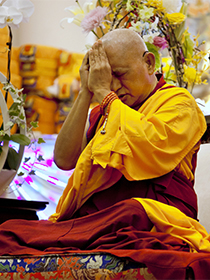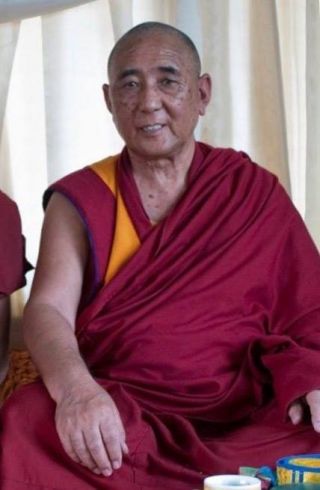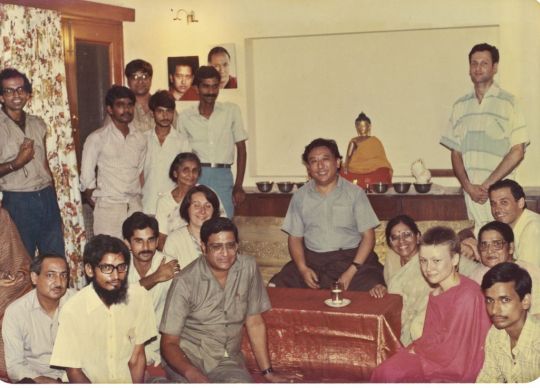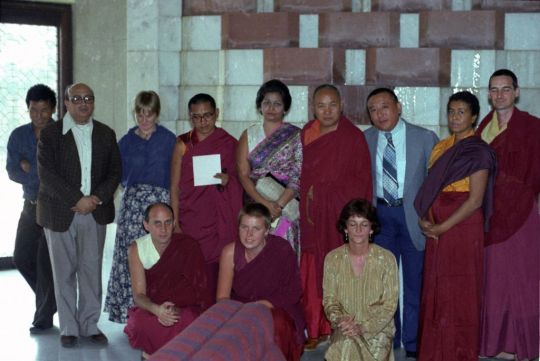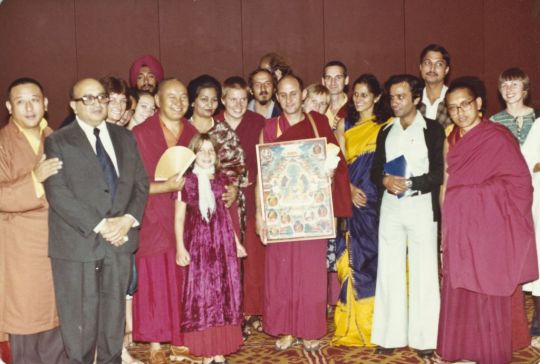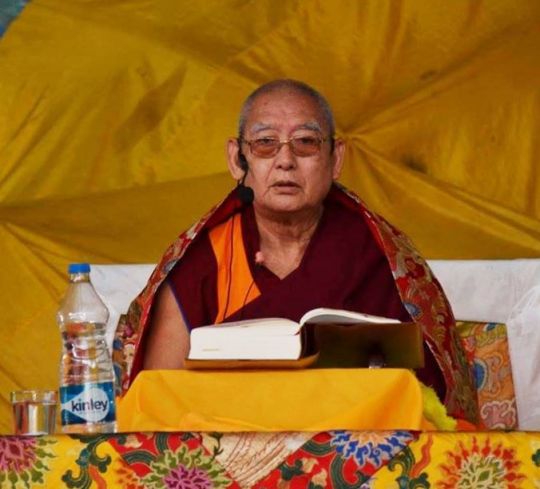- Home
- FPMT Homepage
Foundation for the Preservation of the Mahayana Tradition
The FPMT is an organization devoted to preserving and spreading Mahayana Buddhism worldwide by creating opportunities to listen, reflect, meditate, practice and actualize the unmistaken teachings of the Buddha and based on that experience spreading the Dharma to sentient beings. We provide integrated education through which people’s minds and hearts can be transformed into their highest potential for the benefit of others, inspired by an attitude of universal responsibility and service. We are committed to creating harmonious environments and helping all beings develop their full potential of infinite wisdom and compassion. Our organization is based on the Buddhist tradition of Lama Tsongkhapa of Tibet as taught to us by our founders Lama Thubten Yeshe and Lama Thubten Zopa Rinpoche.
- Willkommen
Die Stiftung zur Erhaltung der Mahayana Tradition (FPMT) ist eine Organisation, die sich weltweit für die Erhaltung und Verbreitung des Mahayana-Buddhismus einsetzt, indem sie Möglichkeiten schafft, den makellosen Lehren des Buddha zuzuhören, über sie zur reflektieren und zu meditieren und auf der Grundlage dieser Erfahrung das Dharma unter den Lebewesen zu verbreiten.
Wir bieten integrierte Schulungswege an, durch denen der Geist und das Herz der Menschen in ihr höchstes Potential verwandelt werden zum Wohl der anderen – inspiriert durch eine Haltung der universellen Verantwortung und dem Wunsch zu dienen. Wir haben uns verpflichtet, harmonische Umgebungen zu schaffen und allen Wesen zu helfen, ihr volles Potenzial unendlicher Weisheit und grenzenlosen Mitgefühls zu verwirklichen.
Unsere Organisation basiert auf der buddhistischen Tradition von Lama Tsongkhapa von Tibet, so wie sie uns von unseren Gründern Lama Thubten Yeshe und Lama Thubten Zopa Rinpoche gelehrt wird.
- Bienvenidos
La Fundación para la preservación de la tradición Mahayana (FPMT) es una organización que se dedica a preservar y difundir el budismo Mahayana en todo el mundo, creando oportunidades para escuchar, reflexionar, meditar, practicar y actualizar las enseñanzas inconfundibles de Buda y en base a esa experiencia difundir el Dharma a los seres.
Proporcionamos una educación integrada a través de la cual las mentes y los corazones de las personas se pueden transformar en su mayor potencial para el beneficio de los demás, inspirados por una actitud de responsabilidad y servicio universales. Estamos comprometidos a crear ambientes armoniosos y ayudar a todos los seres a desarrollar todo su potencial de infinita sabiduría y compasión.
Nuestra organización se basa en la tradición budista de Lama Tsongkhapa del Tíbet como nos lo enseñaron nuestros fundadores Lama Thubten Yeshe y Lama Zopa Rinpoche.
A continuación puede ver una lista de los centros y sus páginas web en su lengua preferida.
- Bienvenue
L’organisation de la FPMT a pour vocation la préservation et la diffusion du bouddhisme du mahayana dans le monde entier. Elle offre l’opportunité d’écouter, de réfléchir, de méditer, de pratiquer et de réaliser les enseignements excellents du Bouddha, pour ensuite transmettre le Dharma à tous les êtres. Nous proposons une formation intégrée grâce à laquelle le cœur et l’esprit de chacun peuvent accomplir leur potentiel le plus élevé pour le bien d’autrui, inspirés par le sens du service et une responsabilité universelle. Nous nous engageons à créer un environnement harmonieux et à aider tous les êtres à épanouir leur potentiel illimité de compassion et de sagesse. Notre organisation s’appuie sur la tradition guéloukpa de Lama Tsongkhapa du Tibet, telle qu’elle a été enseignée par nos fondateurs Lama Thoubtèn Yéshé et Lama Zopa Rinpoché.
Visitez le site de notre Editions Mahayana pour les traductions, conseils et nouvelles du Bureau international en français.
Voici une liste de centres et de leurs sites dans votre langue préférée
- Benvenuto
L’FPMT è un organizzazione il cui scopo è preservare e diffondere il Buddhismo Mahayana nel mondo, creando occasioni di ascolto, riflessione, meditazione e pratica dei perfetti insegnamenti del Buddha, al fine di attualizzare e diffondere il Dharma fra tutti gli esseri senzienti.
Offriamo un’educazione integrata, che può trasformare la mente e i cuori delle persone nel loro massimo potenziale, per il beneficio di tutti gli esseri, ispirati da un’attitudine di responsabilità universale e di servizio.
Il nostro obiettivo è quello di creare contesti armoniosi e aiutare tutti gli esseri a sviluppare in modo completo le proprie potenzialità di infinita saggezza e compassione.
La nostra organizzazione si basa sulla tradizione buddhista di Lama Tsongkhapa del Tibet, così come ci è stata insegnata dai nostri fondatori Lama Thubten Yeshe e Lama Zopa Rinpoche.
Di seguito potete trovare un elenco dei centri e dei loro siti nella lingua da voi prescelta.
- 欢迎 / 歡迎
简体中文
“护持大乘法脉基金会”( 英文简称:FPMT。全名:Foundation for the Preservation of the Mahayana Tradition) 是一个致力于护持和弘扬大乘佛法的国际佛教组织。我们提供听闻,思维,禅修,修行和实证佛陀无误教法的机会,以便让一切众生都能够享受佛法的指引和滋润。
我们全力创造和谐融洽的环境, 为人们提供解行并重的完整佛法教育,以便启发内在的环宇悲心及责任心,并开发内心所蕴藏的巨大潜能 — 无限的智慧与悲心 — 以便利益和服务一切有情。
FPMT的创办人是图腾耶喜喇嘛和喇嘛梭巴仁波切。我们所修习的是由两位上师所教导的,西藏喀巴大师的佛法传承。
繁體中文
護持大乘法脈基金會”( 英文簡稱:FPMT。全名:Found
ation for the Preservation of the Mahayana Tradition ) 是一個致力於護持和弘揚大乘佛法的國際佛教組織。我們提供聽聞, 思維,禪修,修行和實證佛陀無誤教法的機會,以便讓一切眾生都能 夠享受佛法的指引和滋潤。 我們全力創造和諧融洽的環境,
為人們提供解行並重的完整佛法教育,以便啟發內在的環宇悲心及責 任心,並開發內心所蘊藏的巨大潛能 — 無限的智慧與悲心 – – 以便利益和服務一切有情。 FPMT的創辦人是圖騰耶喜喇嘛和喇嘛梭巴仁波切。
我們所修習的是由兩位上師所教導的,西藏喀巴大師的佛法傳承。 察看道场信息:
- FPMT Homepage
- News/Media
-
- Study & Practice
-
-
- About FPMT Education Services
- Latest News
- Programs
- New to Buddhism?
- Buddhist Mind Science: Activating Your Potential
- Heart Advice for Death and Dying
- Discovering Buddhism
- Living in the Path
- Exploring Buddhism
- FPMT Basic Program
- FPMT Masters Program
- FPMT In-Depth Meditation Training
- Maitripa College
- Lotsawa Rinchen Zangpo Translator Program
- Universal Education for Compassion & Wisdom
- Online Learning Center
-
- Prayers & Practice Materials
- Overview of Prayers & Practices
- Full Catalogue of Prayers & Practice Materials
- Explore Popular Topics
- Benefiting Animals
- Chenrezig Resources
- Death & Dying Resources
- Lama Chopa (Guru Puja)
- Lama Zopa Rinpoche: Compendium of Precious Instructions
- Lama Zopa Rinpoche: Life Practice Advice
- Lama Zopa Rinpoche Practice Series
- Lamrim Resources
- Mantras
- Prayer Book Updates
- Purification Practices
- Sutras
- Thought Transformation (Lojong)
- Audio Materials
- Dharma Dates - Tibetan Calendar
- Translation Services
- Publishing Services
- Ways to Offer Support
- Prayers & Practice Materials
-
- Teachings and Advice
- Find Teachings and Advice
- Lama Zopa Rinpoche Advice Page
- Lama Zopa Rinpoche: Compendium of Precious Instructions
- Lama Zopa Rinpoche Video Teachings
- ༧སྐྱབས་རྗེ་བཟོད་པ་རིན་པོ་ཆེ་མཆོག་ནས་སྩལ་བའི་བཀའ་སློབ་བརྙན་འཕྲིན།
- Podcasts
- Lama Yeshe Wisdom Archive
- Buddhism FAQ
- Dharma for Young People
- Resources on Holy Objects
- Teachings and Advice
-
-
*If a menu item has a submenu clicking once will expand the menu clicking twice will open the page.
-
-
- Centers
-
- Teachers
-
- Projects
-
-
-
-
*If a menu item has a submenu clicking once will expand the menu clicking twice will open the page.
-
-
- FPMT
-
-
-
-
-
Countless sentient beings have suffered by being harmed or killed for every grain of rice you eat. Think about the previous grain from which it came. If you understand this, there’s no way you’ll be able to eat simply for your own selfish enjoyment; you’ll always make offerings of your food and drink.
Lama Zopa Rinpoche
-
-
-
- Shop
-
-
-
The Foundation Store is FPMT’s online shop and features a vast selection of Buddhist study and practice materials written or recommended by our lineage gurus. These items include homestudy programs, prayers and practices in PDF or eBook format, materials for children, and other resources to support practitioners.
Items displayed in the shop are made available for Dharma practice and educational purposes, and never for the purpose of profiting from their sale. Please read FPMT Foundation Store Policy Regarding Dharma Items for more information.
-
-
Obituaries
16
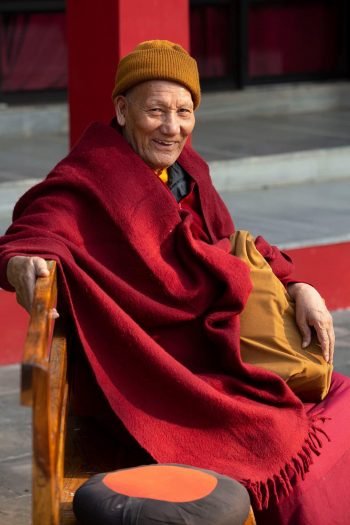
Ladakhi Lama at Root Institute for Wisdom Culture, Bodhgaya, Gaya District, Bihar, India. Photo by Paolo Regis (@paoloregisphotography).
We are saddened to share the news that Ven. Thupten Tsewang (also known as Ladakhi Lama and Baling Lama), born in Ladakh, India, passed away at the age of 92, at Kalpataru Buddha Vihar, Nagpur, Maharashtra, India, on April 25, 2021, of natural causes.
Ladakhi Lama had been an attendant to Indian Buddhist master Khunu Lama Tenzin Gyaltsen Rinpoche (1894–1977). In his later years he was a part-time resident at Root Institute for Wisdom Culture in Bodhgaya, Gaya District, Bihar, India.
Geshe Ngawang Rabga, the FPMT resident geshe at Root Institute from 2016–2020, wrote a kind remembrance of Gen-la, as Ladakhi Lama was sometimes called, to share with the international FPMT community:
“Gen-la was very respectable and close to me. His demise has saddened me deeply. He lived his life as a fully ordained monk and received Dharma teachings from many great masters like His Holiness the Dalai Lama and Kyabje Zopa Rinpoche. Therefore, he made his life a meaningful one. I truly appreciate the life he lived. I pray from my heart that he returns in his next life as a great teacher of the Buddhadharma in general, and especially of the teachings of Lama Tsongkhapa.”
In his younger days, before he ordained, Ladakhi Lama worked as a radio broadcaster at All India Radio in Ladakh. Ven. Tenzin Paldron, center director at Root Institute from 2015–2019, and Annie McGhee, who volunteered at the center, remembered him as an avid reader of The Times of India. “Lama loved to read the newspaper on a daily basis and was very well versed in political affairs in India and loved to discuss politics with the guests that visited,” Ven. Paldron said. Annie added, “He loved a good debate and engaged in many animated discussions over meals at the dining table.”
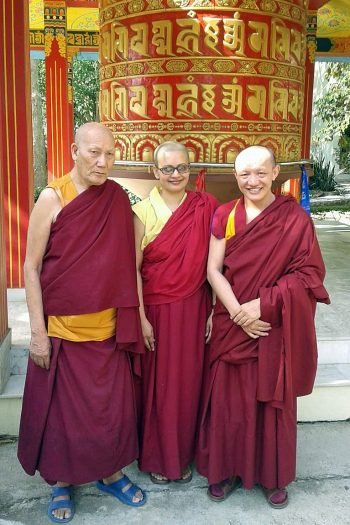
Ladakhi Lama, Ven. Tenzin Paldron, and Geshe Ngawang Rabga at Root Institute for Wisdom Culture, Bodhgaya, Gaya District, Bihar, India. Photo courtesy of Root Institute.
Ladakhi Lama met Khunu Lama in Varanasi in 1954, and Khunu Lama ordained him shortly after their meeting. After six years of being a devoted disciple, he became Khunu Lama’s attendant in 1960. Ven. Paldron said, “He often regaled many of us in the dining hall with stories of the times he spent serving high lamas like Khunu Lama and Denma Locho Rinpoche, and of the rich and varied experiences that he had living as an ordained monk in various temples.”
Annie recalled, “One story which really moved me was when Ladakhi Lama was making lunch—probably rice and dhal—and Khunu Lama told him, ‘Stop cooking now; we have to practice.’ So they had half-cooked rice for lunch! If only we had that dedication and commitment to study and practice the Dharma in the most beneficial way and not waste time on trivialities like food.”
Ladakhi Lama lived in various places, such as Mumbai and Nagpur, before going to Bodhgaya, which is where he met Lama Zopa Rinpoche. Rinpoche requested that Ladakhi Lama stay at Root Institute. “When I became director of Root Institute in June 2015, the first task given to me by Rinpoche was, ‘Take good care of Ladakhi Lama,’” Ven. Paldron said.
He became a much valued presence at Root Institute. “He was like a fatherly figure to us in many ways, often giving us teachings and advice, including making predictions such as who would get ordained,” Ven. Paldron said.
Vicki Taylor, another volunteer at the center, said, “Gen-la was a quiet and friendly presence for several years, bringing humor and cheer to our guests—especially in the dining hall. Despite his advanced age, Gen-la retained the fresh perspective and cheeky sweetness of a child, and I’m sure this gentle presence radiating Dharma contentment benefited many people.”
Indian monk Ven. Tashi Choedup first met Ladakhi Lama at Root Institute in 2017 and had many fond memories of him to share:
“Newly ordained myself, I hadn’t met many Indian ordained Sangha, Himalayan or otherwise; Lama was one of the first. His welcoming nature, warmth, love, and our ability to communicate in Hindi helped us establish a connection from our very first meeting. Lama was generous, sharing stories from his life experiences during our mealtimes. No matter how brief a guest’s visit to Root Institute was, all were touched by Lama’s infectious smile and kindness.
“Lama took me to my first ever Sangha dana ceremony and to many more such gatherings in Bodhgaya thereafter. I fondly remember making a trip to Patna Museum with Lama to pay respects to Buddha relics there.
“I also had the fortune of living in the room next to Lama’s and had the blessing of waking up to Lama’s prayers as early as 3 A.M. every morning. Although we only knew each other for a few years, Lama inspired me to practice Dharma more diligently and gave me the confidence to live an ordained life until the very end.
“Of Lama’s many qualities, one that was always visible was his giving nature. He was always giving away whatever money, food, or resources he had with him. He would never keep anything for himself—except maybe for the packets of Yippee instant noodles, his favorite.”
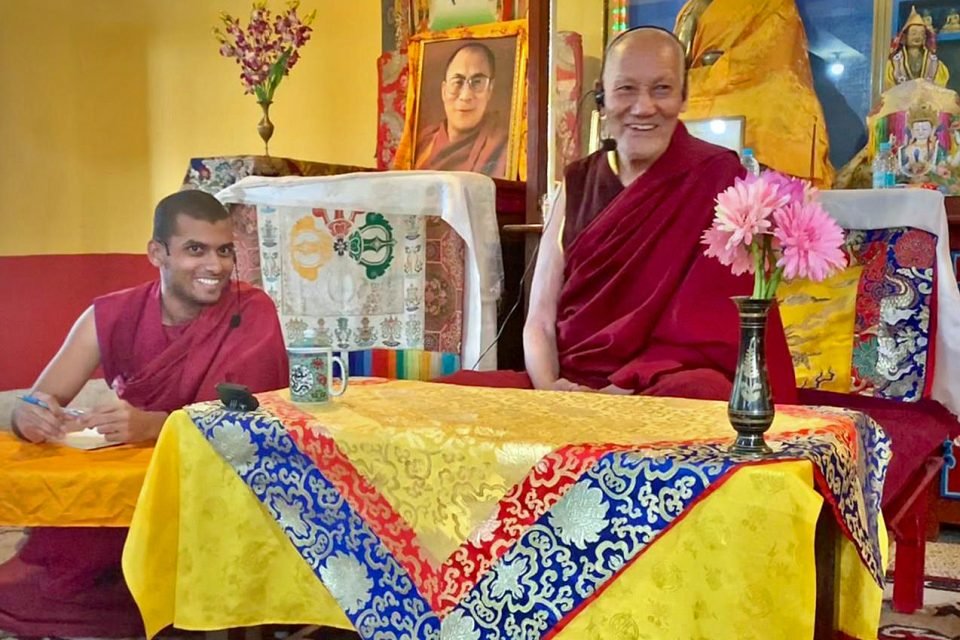
Ven. Tashi Choedup and Ladakhi Lama at Root Institute for Wisdom Culture, Bodhgaya, Gaya District, Bihar, India, November 2019. Photo by Ven. Thubten Munsel.
Inder Kant, who met Ladakhi Lama in 2016 in Bodhgaya, commented on his kindness and humor as well as his profound generosity, recalling a story about visiting a very sick 102-year-old lama at a Tibetan monastery in Bodhgaya with Ladakhi Lama. “We gave the lama some food we had brought for him,” Inder said. “Ladakhi Lama used to visit the elderly lama, looking after him. The lama’s room was messy so Ladakhi Lama and I cleaned the room and made his bed with a new bed sheet. It was overwhelming to see the kindness of Ladakhi Lama.”
Ven. Paldron recounted another quality of Ladakhi Lama: “He was not afraid to challenge someone’s authority, no matter what their position was, if Lama thought they were behaving unethically or inappropriately. He shared various stories of how he had confronted bullies—including some lamas in temples—to make sure that the vulnerable and needy were treated fairly and justly. Lama did not care about his reputation or what would happen to him. If something needed to be corrected, he spoke out against it very fiercely.”
Ladakhi Lama was also very knowledgeable about the history of Bodhgaya and the Mahabodhi Stupa, as well as the significance of many of the small and large stupas around the main temple. He also knew all the main pilgrimage sites.
“In early October 2016, I arrived at Root Institute to volunteer for the winter season,” Annie McGhee said. “I had longed to go to Vikramashila, the home monastery of Lama Atisha. This pilgrimage site is in northeastern Bihar, a region unsafe to travel to as a single woman. I had made many prayers to go and had mentioned this to two friends. One morning I was standing in the breakfast queue when Ladakhi Lama came up to me and said, ‘You want to go to Vikramashila? OK, I will take you.’ I was overjoyed but a little concerned for Lama because it would be a long journey with rough conditions.
“A few of us from Root Institute made the trip together, traveling for ten hours one way by Jeep. At the entrance we stopped to take it all in, as it was a large and important monastic university in its time. Lama remarked, ‘Here is what is left of stupas that would have held the 108 arhats who resided at Vikramashila.’ He was quiet and reflective at other places but led us in many practices and prayers at some of the holy sites.”

Ladakhi Lama and Lama Zopa Rinpoche at the Mahabodhi Stupa, Bodhgaya, Gaya District, Bihar, India, 2015. Photo by Andy Melnic.
Sharing her favorite memory of Ladakhi Lama, Vicki Taylor said, “Lama Zopa Rinpoche had requested from Gen-la the oral transmission of Gampopa’s classic lamrim text The Jewel Ornament of Liberation, which he himself had received from Khunu Lama. The transmission took more than one session, and a few of us were gathered in the Root Institute’s small gompa, about to start a subsequent session. When Rinpoche arrived, he showed great respect to Gen-la by trying to prostrate to him before we resumed. Gen-la could not bear to see Rinpoche struggle to prostrate to him, due to Rinpoche’s manifesting signs of a stroke and especially because of Gen-la’s deep respect and appreciation for Rinpoche. So Rinpoche was trying to prostrate, and Gen-la was trying to hold one of his arms to prevent him, all the while politely imploring Rinpoche not to prostrate. I remember the two of them, in a sort of ‘battle of politeness,’ intent on showing great respect to each other. It was beautiful to see.”
The practice of bodhicitta was very close to Ladakhi Lama’s heart. At Root Institute, he also gave the transmission of the verses from Jewel Lamp: A Praise of Bodhicitta, written by Khunu Lama.
Because it was his wish to go to Tushita Pure Land once he departed his body, a butter lamp is being offered in honor of Ladakhi Lama at Tushita Meditation Center, the FPMT center in Dharamsala, India, over the forty-nine day period along with daily prayers and dedications. May all of Lama’s wishes be fulfilled and may he quickly return to guide us on the path to attain enlightenment for the benefit of all sentient beings.
For more on practices recommended by Lama Zopa Rinpoche at time of death and other resources to support yourself and loved ones at time of death, please visit fpmt.org/death/.
FPMT.org and Mandala Publications brings you news of Lama Zopa Rinpoche and of activities, teachings, and events from over 160 FPMT centers, projects, and services around the globe. If you like what you read, consider becoming a Friend of FPMT, which supports our work.
- Tagged: geshe ngawang rabga, khunu lama rinpoche, ladakh, ladakhi lama, obituaries, root institute, vikramashila
31
Chandramani Kumar Passes Away
Chandramani Kumar, 55, died in Patna, Bihar, India, on May 17, 2021, of COVID
By Root Institute for Wisdom Culture former director Ven. Tenzin Paldron and former volunteer Ven. Tashi Choedup
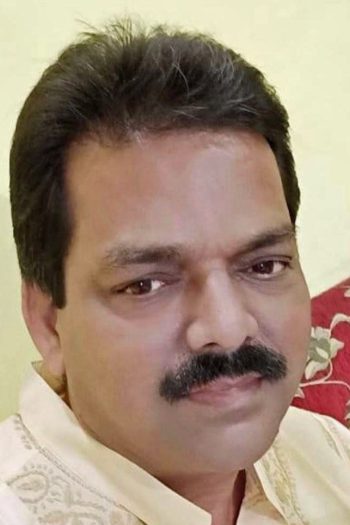
Mr. Chandramani Kumar; photo courtesy of his family
Chandramani Kumar, fondly known as Chunnu ji, was one of the most respected and well-known people in Bodhgaya. He was the founder of two grocery stores that catered to the needs of several of the monasteries and pilgrims visiting the holy town. The Root was one of the institutes that Chunnu ji devotedly served for almost fifteen years. Previous director Ven. Thubten Labdron (Trisha Donnelly), who passed away in 2015, was cautious in trusting many people in Bodhgaya. She considered Chuunu ji to be a trusted loyal friend and advisor of Root.
Ven. Tashi Choedup recalled that when the first lockdown began in March 2020, twenty guests became stranded at Root. The Root staff were sent off-duty as a precautionary measure, leaving Root in a vulnerable and challenging situation. Chunnu ji, who had reliably supplied Root with groceries during busy and off-seasons, once again came through by delivering all the needed groceries and goods right to the Root front gate in his personal vehicle.
Ven. Tenzin Paldron said Chuunu ji was a soft spoken gentleman who was trustworthy, loyal, and reliable. He will be remembered by many people in Bodhgaya as a caring, compassionate, and conscientious gentleman who served others with a gentle kind heart and warm smile. He leaves behind his wife and two sons.
Lama Zopa Rinpoche requests that students who read obituaries pray that the person mentioned finds a perfect human body, meets a Mahayana guru, and becomes enlightened quickly, or be born in a pure land where the teachings exist and they can become enlightened.” While reading obituaries we can also reflect on our own death and impermanence prompting us to live our lives in the most meaningful way. More advice from Lama Zopa Ripoche on death and dying is available on Lama Zopa Rinpoche’s advice page.
31
Atul Chopra, 61, died in Gorakhpur, Uttar Pradesh, India, on May 7, 2021, of COVID-19
By Marcel Bertels, director of FPMT project Maitreya Buddha Kushinagar
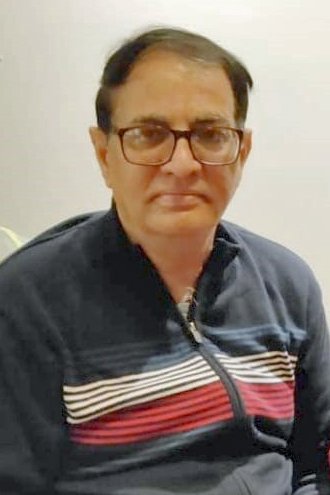
Mr. Atul Chopra; photo courtesy of the family
I met Atul in 2001. After deciding to relocate the Maitreya Project from Bihar, India, it was concluded that we should explore the availability of land at other holy sites outside of Bihar. The most promising lead came from the Government of Uttar Pradesh, a state in northeast India. The government expressed they were very keen to host the Maitreya Project and promised to provide free land at any holy site we desired.
When a team from Maitreya Project visited Kushinagar, they were greeted by a welcome party that included Atul Chopra. The government had asked Atul to assist because he had been active in Buddhist projects in the Kushinagar area for quite some time.
After His Holiness the Dalai Lama confirmed Kushinagar as the best place for the project, boots on the ground were needed quickly. Atul presented himself as the natural person to help us coordinate with the Government of Uttar Pradesh.
It turned out Atul was very skillful at this task. He was extremely determined, persistent, hardworking, and would generally never take “no” for an answer. He told me during one of our many road trips that he just loved challenges! Not only that, he was tireless. Atul’s many trips away from his home base in Gorakhpur—to the Uttar Pradesh State Capital of Lucknow, the project site in Kushinagar, and New Delhi—must have run into the hundreds over his seventeen years with the project. He was a very pragmatic and simple person who was quite satisfied with budget hotels and run-of-the-mill train travel.
Atul called upon all of his resources in the government, bureaucracy, and judiciary, as well as his friends, for lobbying and expert advice on behalf of the Maitreya Project. His critical accomplishments include the drafting of an excellent Memorandum of Understanding with the Government of Uttar Pradesh; the finalization of the land site; the execution of the Lease Agreement; and the subsequent taking possession of the land. He held the fort for seventeen years and remained a mainstay of the project until his resignation in late 2017. Atul also showed his kindness by assisting other FPMT projects in India when asked for his advice.
Atul and his wife were both struck by COVID in April 2021 and were admitted to the intensive care unit in Gorakhpur. Atul seemed to be recovering well, but suddenly passed away from a heart attack on May 7. He is survived by his wife Geetu, son Utkarsh, and daughter Sanjoli.
Lama Zopa Rinpoche requests that students who read obituaries pray that the person mentioned finds a perfect human body, meets a Mahayana guru, and becomes enlightened quickly, or be born in a pure land where the teachings exist and they can become enlightened.” While reading obituaries we can also reflect on our own death and impermanence prompting us to live our lives in the most meaningful way. More advice from Lama Zopa Ripoche on death and dying is available on Lama Zopa Rinpoche’s advice page.
28
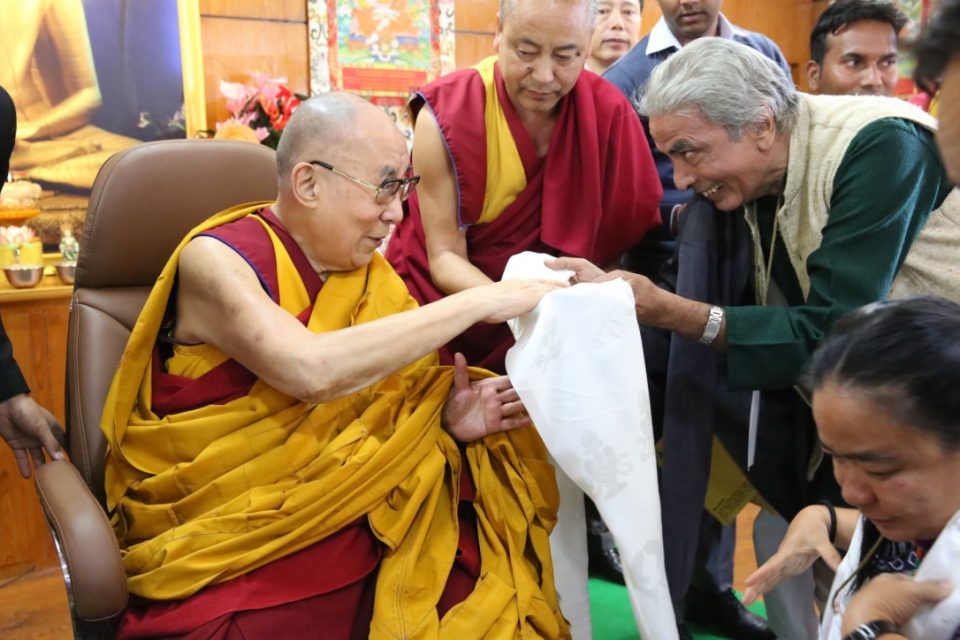
His Holiness the Dalai Lama with Naresh Mathur. Photo courtesy of the Office of His Holiness the Dalai Lama.
We are saddened to share the news that Naresh Sahai Mathur passed away at the age of 67, in New Delhi, India, on April 25, 2021, of COVID-19. Naresh was an early student of FPMT founders Lama Thubten Yeshe and Lama Zopa Rinpoche, and a long-time FPMT volunteer. Kabir Saxena, also a long-time FPMT student who currently serves as the spiritual program coordinator at Tushita Mahayana Meditation Centre in New Delhi, wrote a personal remembrance of Naresh to share with the international FPMT community.
By Kabir Saxena
With the recent untimely passing away of Naresh Mathur—another victim of the second murderous wave of COVID-19—the Indian Buddhist sangha, his friends worldwide, as well as the Tibetan community, have lost an invaluable supporter, legal advisor, and much beloved friend.
Naresh was born in Old Delhi in 1954, close to where some twenty-five years later the pioneers of Tushita Mahayana Meditation Centre would be living. It’s a testimony to his great intellectual and spiritual thirst that he was willing and able to seek beyond his quality education in sociology and law at two of Delhi’s esteemed establishments and find himself at the doors of both Tushita Mahayana Meditation Centre and Tibet House in Delhi.
While the practice of law provided his bread and butter, it was Buddhist studies that quickly established their prominence in Naresh’s heart and mind. Early on he had the great good fortune to receive personal, one-on-one teachings on lamrim and Madhyamaka from the renowned Geshe Palden Drakpa, who became a lifelong friend of the family and a recipient of Naresh’s generous medical help. It was, I believe, this deep experience of the teachings with Geshe-la that made Naresh a lifelong proponent of the sublime Nalanda parampara (tradition), with its emphasis on the guru-disciple relationship, logical inquiry, and debate. It was to these teachings that Naresh returned again and again; even in the last decade of his life, he was an important part of the core group of students at Geshe Dorji Damdul’s Tibet House Nalanda Masters Course.
Naresh was a lover of knowledge, a philosopher in the true sense of the word, and all his life he combined that with his work as a lawyer in the High and Supreme Courts in Delhi.
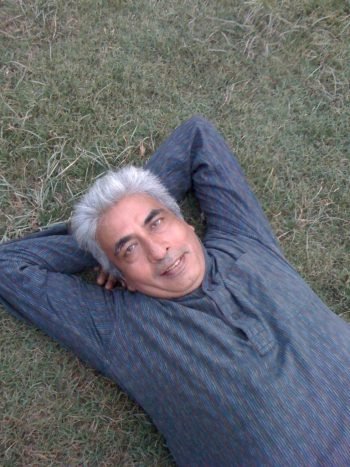
Naresh Mathur
When I first met him in 1980, he was a bright and extremely handsome young man, much impressed by his contact with Lama Thubten Yeshe and Lama Zopa Rinpoche. Naresh went on to be a director of Tushita Mahayana Meditation Centre, an organizer of the Dharma Celebrations with His Holiness the Dalai Lama in Delhi, and the creator of Root Institute for Wisdom Culture’s Trust Deed in 1984 in Bodhgaya. He remained a trustee until a few months before his death.
His dedication to the cause of bringing the Dharma back to Indian people was profound and lasting. He participated in the teachings His Holiness gave to small groups of Indian students in the early 1980s and despite his heavy workload would, almost thirty years later, travel to Bodhgaya for the weekends to give teachings in Hindi to local students.
Naresh unstintingly helped the Tibetan cause with his legal talents and the list of his efforts on their behalf would be too long to include here. As an example, it was largely due to his legal actions that the Tibetan Colony of Majnu Ka Tila in Delhi was saved from destruction. Tenzin Geyche Tethong, former secretary to His Holiness, recalled how he had known Naresh since 1980 and how he greatly admired his interest in and knowledge of Buddhism, and also appreciated Naresh’s contribution to the Dalai Lama Trust of which he was a trustee.
In addition to his connection with Lama Yeshe, Lama Zopa Rinpoche, and FPMT, Naresh had a close connection with Dzongsar Jamyang Khyentse Rinpoche and his Deer Park Institute in Bir, as well as with Samdhong Rinpoche, whose Gandhian vision, critique of modernity, and Dharma advice were like nectar for Naresh.
Naresh was a lover of the meditative dhrupad style of Indian classical music, and we also spent many happy moments listening to Bob Dylan together. He could also be quite mischievous, and we would especially enjoy making silent and secret fun of speakers at conferences whom we considered not up to the mark.
He was a practitioner, especially of the Madhyamaka and the Kalachakra, and was increasingly drawn to extended practice in the last year of his life, according to his wife, Antonella. Throughout his life he had inspired and encouraged a younger generation of students by his example.
For me, and I am sure for many others, including his dear circle of Italian and international friends, Naresh was like family. His deep soulful eyes were those of the eternal seeker and lover; they grabbed you. My father, to whom Naresh was very loving and generous, used to say that going by Naresh’s piercing gaze, he was always in a state of otherworldly intoxication!
In his last year, during long walks together in the woods near his home in south Delhi, Naresh would always steer the conversation to the Dharma, the importance of a grounding in lamrim, and his great love and obsession: the presentation of emptiness in the Gelug tradition. Despite his allegiance to many lamas of different schools of Tibetan Buddhism, he always seemed to be happily and no doubt karmically tethered to the pole of Lama Tsongkhapa’s works and Geshe Palden Dragpa’s teachings.
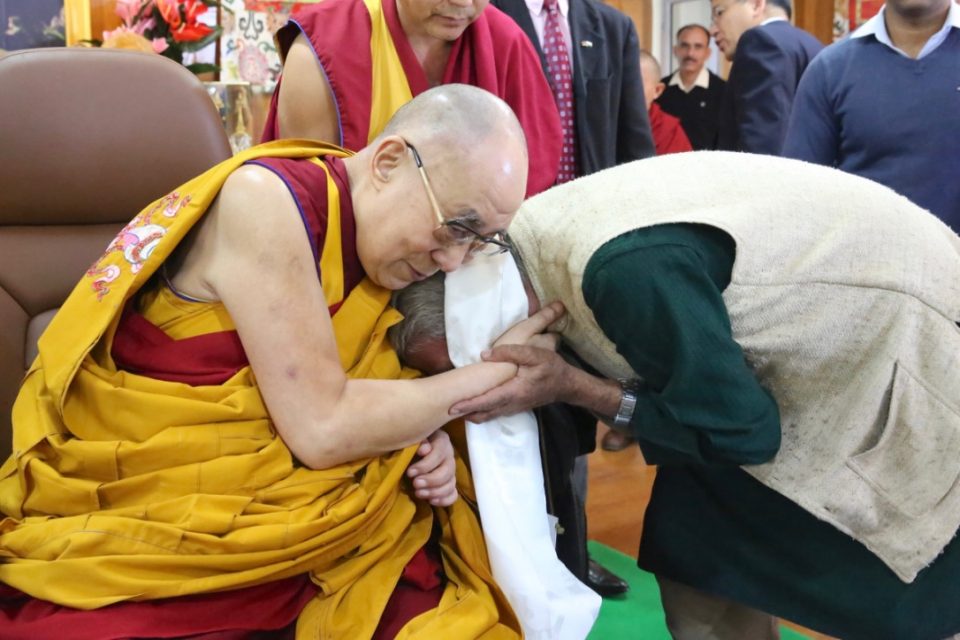
His Holiness the Dalai Lama with Naresh Mathur. Photo courtesy of the Office of His Holiness the Dalai Lama.
After his passing, His Holiness the Dalai Lama made the encouraging pronouncement that Naresh was his disciple, that we should not worry, and that he would take a good rebirth and would remember this life of his. The passing of this kind-hearted and generous man, still somewhat unreal and unbelievable to some of us, leaves a big void in many lives. Naresh is survived by his wife, Antonella, a gifted healer; daughter, Mudita, a talented graphic designer; and son, Atisha, a profound, upcoming teacher of the Dharma, especially of Buddhist logic, the subject matter his dear departed father so admired and communicated so readily to those fortunate enough to cross his path.
The FPMT India community organized a moving online prayer meeting and memorial for Naresh Mathur on May 5, 2021, with Naresh’s family and many long-time students around the world joining in. You can watch the two-hour recording of the Zoom call:
https://www.facebook.com/1652241455007411/videos/457118005515720/?__so__=channel_tab&__rv__=all_videos_card
For more on practices recommended by Lama Zopa Rinpoche at time of death and other resources to support yourself and loved ones at time of death, please visit fpmt.org/death/.
FPMT.org and Mandala Publications brings you news of Lama Zopa Rinpoche and of activities, teachings, and events from over 160 FPMT centers, projects, and services around the globe. If you like what you read, consider becoming a Friend of FPMT, which supports our work.
- Tagged: kabir saxena, naresh mathur, obituaries, ven. kabir saxena
30
Arvind Kumar Singh, 55, died in Gaya District, Bihar, India, on April 25, 2021, of COVID-related complications
By Ven. Tenzin Paldron, Root Institute for Wisdom Culture former director, and former volunteer Ven. Tashi Choedup

Mr. Arvind Kumar Singh; photo courtesy of the family
Mr. Arvind Kumar Singh, affectionately known as Singh ji, worked at Root Institute for Wisdom Culture, the FPMT center in Bodhgaya, Gaya District, Bihar, India, as an entrance gate guard for more than twenty years. He was a valuable senior member of the Root Institute family.
Singh ji was well liked and respected by his peers and the many volunteers and directors who served Root throughout his years of service. He cheerfully welcomed each and every guest and visitor who passed through our entrance gate.
He is survived by his wife, two sons, and daughter Pooja, who also have deep connections to Root. The children studied at Maitreya School, a project of Root. Pooja worked at Shakyamuni Buddha Clinic, another social service project of Root, for seven years as a female health educator.
Singh ji’s death is a deep loss to the community. He will be dearly missed, and his memory will be fondly cherished by many in the years to come.
Lama Zopa Rinpoche requests that students who read obituaries pray that the person mentioned finds a perfect human body, meets a Mahayana guru, and becomes enlightened quickly, or be born in a pure land where the teachings exist and they can become enlightened.” While reading obituaries we can also reflect on our own death and impermanence prompting us to live our lives in the most meaningful way. More advice from Lama Zopa Ripoche on death and dying is available on Lama Zopa Rinpoche’s advice page.
1
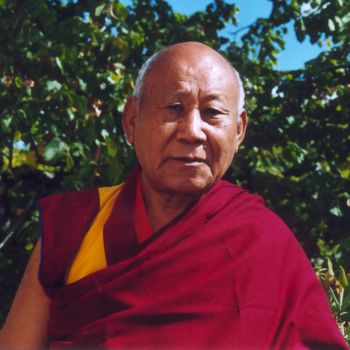
Geshe Losang Tengye. Photo courtesy of Institut Vajra Yogini.
Geshe Losang Tengye, who played an important role in helping establish Tibetan Buddhism in the West, stopped breathing in his room at Institut Vajra Yogini in France on Friday, October 19. Geshe Tengye stayed in clear light meditation for five days. He was 92.
Geshe Tengye was born in Lhatse, Tibet, in 1927. He went to the local monastery at the age of six. He followed a traditional path of in-depth monastic Buddhist study until the 1959 Chinese takeover of Tibet. He went into exile in India and continued his geshe studies at Buxa Chogar, the camp for refugee monks in Buxa Duar, West Bengal, India. Despite illness and hardship, Geshe Tengye received the lharampa geshe degree in 1969.
In 1980, at the request of FPMT co-founder Lama Thubten Yeshe, Geshe Tengye became the resident teacher at Institut Vajra Yogini (IVY), the newly established FPMT center located in the south of France near Toulouse. Due to Geshe Tengye’s infinite patience, wisdom, and compassion, IVY has grown into a large and flourishing Dharma center. He was much loved by his students and will be deeply missed.

Sangha and lay students doing prayers and practices for Geshe Tengye, Institut Vajra Yogini, France, October 2019. Photo courtesy of Institut Vajra Yogini.
Yangsi Rinpoche, who was a close student of Geshe Tengye, arrived at IVY from the United States on Saturday, October 21. He joined with Geshe Tenzin Loden, the current resident geshe at IVY, and Geshe Losang Jamphel and Geshe Jamphel Gyaltsen, the resident geshes at the nearby Nalanda Monastery, doing daily pujas as advised by Ganden Tripa Lobsang Tenzin Rinpoche, who was a close friend of Geshe Tengye. Western Sangha and lay students also did daily prayers and practices for Geshe Tengye. On Monday, October 28, the body of Geshe Tengye was taken to a local crematorium for cremation. IVY students will continue to do prayers and practices for Geshe Tengye through the forty-nine days, which ends on December 5.
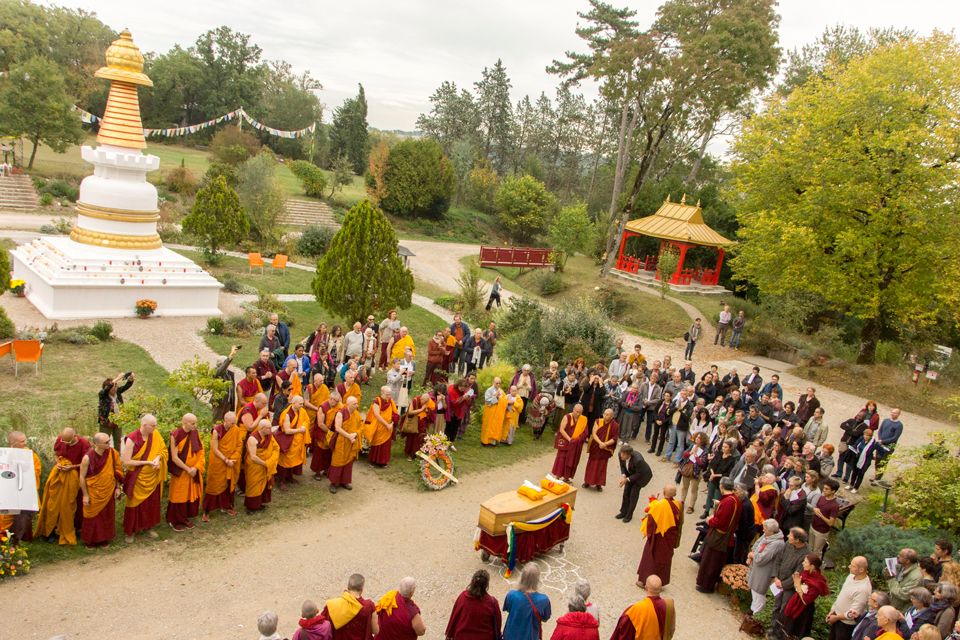
Sangha and lay students gathered for Geshe Tengye at Institut Vajra Yogini, France, October 2019. Photo courtesy of Institut Vajra Yogini.
Read the obituary for Geshe Losang Tengye published in Mandala Issue One 2020.
Learn more about Institut Vajra Yogini, on their website:
https://www.institutvajrayogini.fr/indexA.html
FPMT.org and Mandala Publications brings you news of Lama Zopa Rinpoche and of activities, teachings, and events from over 160 FPMT centers, projects, and services around the globe. If you like what you read, consider becoming a Friend of FPMT, which supports our work.
20
Paying Tribute to Geshe Pema Tsering
On February 11, 2017, Geshe Pema Tsering, who served as resident teacher at Buddha House in Adelaide, Australia, for nine years entered into clear light meditation after passing away. Mandala received this tribute to Geshe-la from Buddha House director Gabe Edwards on February 16, while Geshe-la was in his fifth day of clear light meditation:
It is with great sadness that we heard of the passing of most precious Geshe Pema Tsering, who was our resident teacher here at Buddha House from September 2001 to December 2010. He returned to Sera Je Monastery in December 2013 and remained there until his passing.
Geshe-la was born in 1939 in Dhargye Village in Kham province, Tibet, the only child of farming parents. He became ordained as a monk in Dhargye Monastery at the age of seven and at seventeen went to Sera Monastery in Lhasa where he met his spiritual teacher, Kyabje Khensur Kangyur Lobsang Thubten Rinpoche, who was also Buddha House’s former resident teacher, and continued his studies with the aim of getting his Geshe degree. He escaped to India at twenty years old following His Holiness the Dalai Lama’s departure from Tibet. Despite the hardships of traversing the snow covered mountains of the Himalayas, Geshe-la said his mind remained happy and buoyed by the positive spirit of his companions.
After ten years in a refugee camp in Buxa Duar, India, Geshe-la traveled to Karnataka in South India and for three years cleared the jungle and assisted in the re-establishment of Sera Je Monastery. He was thirty-three years old when he resumed his geshe studies under Khensur Rinpoche and Geshe Torche. In 1980 he achieve the highest level Geshe Lharampa degree.
Geshe-la had many students in Adelaide and India, and despite his high qualifications, he was widely known for his exceptional humility, kindness, and compassion.
As expressed by student Wendy Cook: “Geshe Pema Tsering passed away four days ago. Although he is considered clinically dead, he is, however, still in meditation, as his most subtle consciousness continues to reside in his body at his heart. The great yogis of Tibet who have committed their lives to deep practice and inquiry manifest this at the time of death. It is considered a very powerful time as one resides in the clear light with great wisdom and motivated by compassion for all beings. Geshe-la is in his final meditation at Sera Je Monastery in South India where the monks are engaged in practice, meditation, and chanting around the clock to support him in his transition. When his consciousness leaves the body, there will be signs, and then the monks will cremate Geshe-la’s body. This is how a great master of Tibet passes. Extraordinary. Without these precious lineage holders, the treasure of Tibetan Buddhism would not have been reestablished in India and then brought to the West.”
Ruth Gamble, scholar and translator for Geshe Pema Tsering while at Buddha House, so eloquently and poignantly expressed: “Gen-la always talked about impermanence. His mother died when he was young. In 1959 an artillery shell hit the room next to him killing his friend. Minutes later, he walked out of his home, and weeks later, he walked out of his country. He lost teachers and friends in refugee camps, and almost lost his thumb clearing the jungle in South India building a new monastery.
“But even in the midst of all this, he maintained a startlingly sharp sense of humor, fun, and wonder. His hero was a senior monk who told him that ‘the only things a monk needs are a sack and a rope, so it’s easy to get rid of his body when he dies.’ He thought this was a hilarious line. I guess his dark humor explains why he also found former prime minister John Howard and former president George W. Bush amusing: he seemed to think they were personally responsible for keeping the streets clean and the toilets flushing, so they can’t be all bad. He was fascinated by garbage trucks, sewerage works, and construction sites. They seemed to him, a farmer’s son who helped carve a monastery out of a jungle, as an ingenious magic show. He also loved soccer, but rather than barracking for a team, he barracked for a particular score: 3-3. That way, he said, no one felt sad about losing, but there were lots of goals.
“None of this (especially finding John Howard funny) is why he is my hero, though. He’s my hero because I saw him change his state of mind again and again. Rather than let anger, frustration, and jealousy—or even physical pain—shape his mind, he could transform his thoughts in an instant (or sometimes two). His anger would evaporate, his frustration would turn to patience, and his habitual compassion would reassert itself. The good thing about impermanence, he would say, is that it allows change.”
A complete obituary for Geshe Pema Tsering will be included as part of the July-December 2017 issue of Mandala.
- Tagged: geshe pema tsering, obituaries
- 0
17
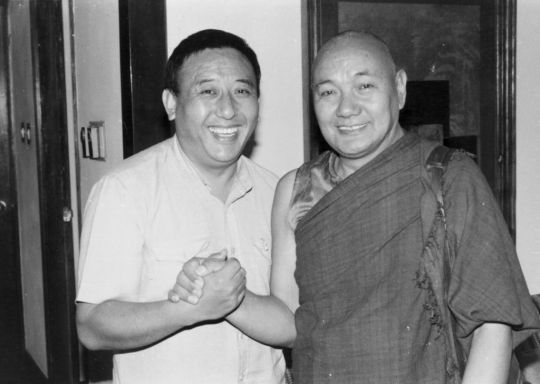
Gelek Rinpoche with Lama Yeshe at Rinpoche’s house. Lama Yeshe would go there to buy texts. Photo courtesy of Lama Yeshe Wisdom Archive.
It was with great sadness that we at FPMT International Office learned of the passing of Gelek Rinpoche (often spelled Gelek Rimpoche), founder of the Jewel Heart centers, on February 15, 2017. Rinpoche was a close friend of FPMT founder Lama Yeshe and spiritual director Lama Zopa Rinpoche.
Long-time student and director of Lama Yeshe Wisdom Archive Nicholas Ribush shares a personal reflection and some historical photos of Rinpoche from the Archive:
In January 1977, Lama Yeshe sent me to Delhi to start Tushita Mahayana Meditation Centre “in order to help repay the kindness of the Indian people to the Tibetans.” Lama explained that the Buddhadharma had come to Tibet from India, had largely been lost in India, had been preserved and developed in Tibet, and now was the time to reintroduce it to its land of origin.
It took a couple of years to find the right place but I eventually found a great house to rent in the lovely New Delhi suburb of Shantiniketan. During this period, in 1978, I first met Gelek Rinpoche at his home in Defence Colony, which was the base for his publishing many important Gelug texts and was where Lama Yeshe went to buy sets of these for his developing Western centers.
After we found the house for Tushita in 1979, Lama suggested I ask Gelek Rinpoche to teach, and he kindly accepted. That was the beginning of a seven-year collaboration between Rinpoche and Tushita. He was a wonderful teacher and connected with both Indian and Western students. I think it was as a result of the connections that Rinpoche made with some American students staying at Tushita (one of our functions was as a guest house for Westerners passing through Delhi) that led to Rinpoche being invited to the USA to teach and later to the establishment of his own organization, the Jewel Heart centers, starting in the late 1980s.
Rinpoche also actively participated in Tushita’s Dharma Celebrations. The first was held at the Oberoi Hotel and Rinpoche was one of the featured panelists. The guest of honor was supposed to be His Holiness the Dalai Lama but he couldn’t make it, so we got the home minister Giani Zail Singh, who later became president of India. Rinpoche was also a prominent guest at our Second Dharma Celebration, held at the Hotel Ashok.
Lama Yeshe and Lama Zopa Rinpoche used to pass through Delhi at least twice a year and would stay at Tushita. Most times Gelek Rinpoche would visit them on at least one of those visits and they would enjoy meals with him at the center or take him to one of Lama’s sister’s restaurants or to one of the five-star hotels around town.
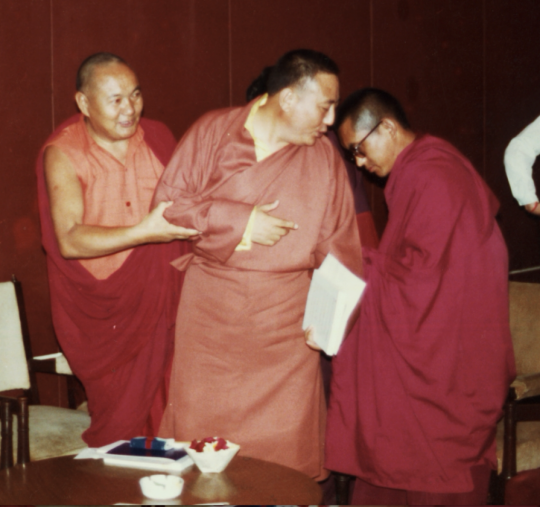
Lama Yeshe and Lama Zopa Rinpoche pushing Gelek Rinpoche into the top seat. Photo courtesy of Lama Yeshe Wisdom Archive.
After Rinpoche moved to the USA and I arrived soon after, I would meet him only occasionally and sometimes speak by phone, but I always felt a strong connection with him and rejoiced at the success of his Dharma work. Gelek Rinpoche’s passing is a great loss to his students, the Dharma, and the world.
Rinpoche’s official biography may be found on the Jewel Heart website.
An interview with Rinpoche appeared in Mandala in 1999:
https://fpmt.org/mandala/archives/older/mandala-issues-for-1999/may/gelek-rinpoche/
Rinpoche also talks about his early life in his book Good Life, Good Death. If you “look inside” the book on Amazon, you can read Robert Thurman’s very interesting introduction online.
A complete obituary for Gelek Rinpoche will be included as part of the July-December 2017 issue of Mandala.
- Tagged: gelek rinpoche, obituaries
- 0
2
We are sad to announce that on July 31, 2016, Sera Je abbot Khen Rinpoche Geshe Gendun Choephel suddenly passed away. Among Khen Rinpoche’s many students is Tenzin Ösel Hita, the recognized reincarnation of FPMT founder Lama Yeshe.
Khen Rinpoche Geshe Gendun Choephel was born in 1941 in Karze in eastern Tibet. He later joined Sera Je Monastery in 1955 and went into exile in India in 1959, joining the Buxa Duar community to study and practice. He was among the foremost group who re-established Sera Je in Bylakuppe, South India. After earning his Lharampa Geshe degree, Khen Rinpoche began teaching at the monastery and did so for the rest of his life. He was enthroned as the 75th abbot of Sera Je Monastery on July 18, 2016.

Enthronement ceremony of Khen Rinpoche Geshe Gendun Choephel, Sera Je Monastery, Bylakuppe, South India, July 2016. Photo via http://www.serajeymonastery.org
“My dearest and most precious Teacher, Friend, Mother, Father and Khen Rinpoche, Geshe Gendun Choephel, just passed away in a very sudden way,” Ösel wrote on his Facebook page on July 31. “He was the closest person in my life, he raised me and gave me everything, taught me and loved me like no one else. It is devastating and so hard to accept, but I feel joy for having known him and it has been such an honor to grow up under his guidance. Thank you so much Gen-la, you are always in my heart.”
Mandala will have a complete obituary for Khen Rinpoche Geshe Gendun Choephel in the January-June 2017 issue.
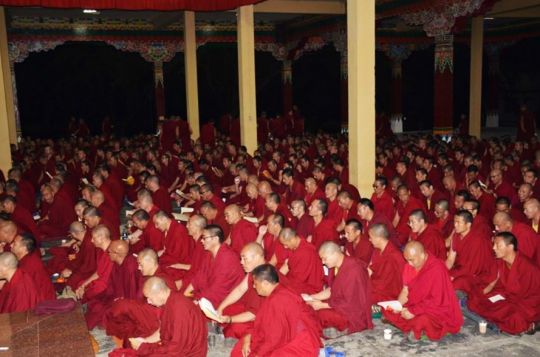
Sera Je monks reciting texts for Khen Rinpoche Geshe Gendun Choephel, Sera Je Monastery, South India, July 2016. Photo via Facebook (Sera Jey Monastery).
25
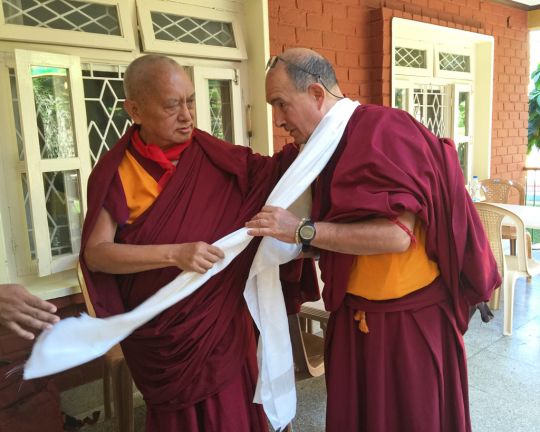
Lama Zopa Rinpoche offering Ven. Thubten Kunsang a khata blessed by His Holiness the Dalai Lama for Ven. Kunsang, Sera Monastery, India, January 2016. Photo by Ven. Roger Kunsang.
We are sad to share the news that the French monk Ven. Thubten Kunsang (Henri Lopez) passed away on Sunday, July 24, at 11:46 a.m. in India due to cancer. Ven. Kunsang traveled with Lama Zopa Rinpoche for many years, recording Rinpoche’s talks and spontaneous teachings for the Lama Yeshe Wisdom Archive and taking thousands of photos that have been shared on FPMT.org and in Mandala magazine. He was a familiar and friendly face within the international FPMT community, known for his incredible warmth, generosity and kindness. He will be missed by many, many people around the world.
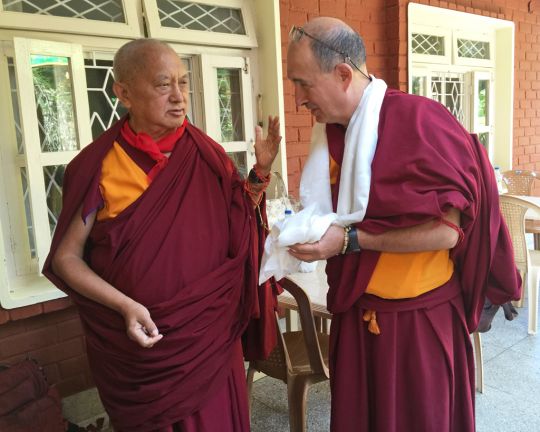
Lama Zopa Rinpoche with Ven. Thubten Kunsang, Sera Monastery, India, January 2016. Photo by Ven. Roger Kunsang.
Lama Zopa Rinpoche sent the following message to ordained Sangha after Ven. Kunsang had passed away.
Dear Sangha,
We believed there was real Kunsang and now that real Kunsang is not there, but that’s the reality, and like that all the phenomena, yourself, action and object, all phenomena, samsara and nirvana are like that.
Please right now when you get this, please to do the short Medicine Buddha sadhana and Padmasambhava prayer Sampa Lhundrupma.
Dedicated to Ven. Kunsang (Henri Lopez) who has just passed away in India at 11:46 a.m.
Dedicate that he may be immediately born in a pure land where he can achieve enlightenment as quickly as possible or to receive at least a perfect human rebirth, meet the Mahayana teachings, meet a perfectly qualified Mahayana Guru, who reveals the path to enlightenment and by pleasing the holy mind of the virtuous friend, then by himself to achieve enlightenment as quickly as possible.
With much love and prayers,
Lama Zopa
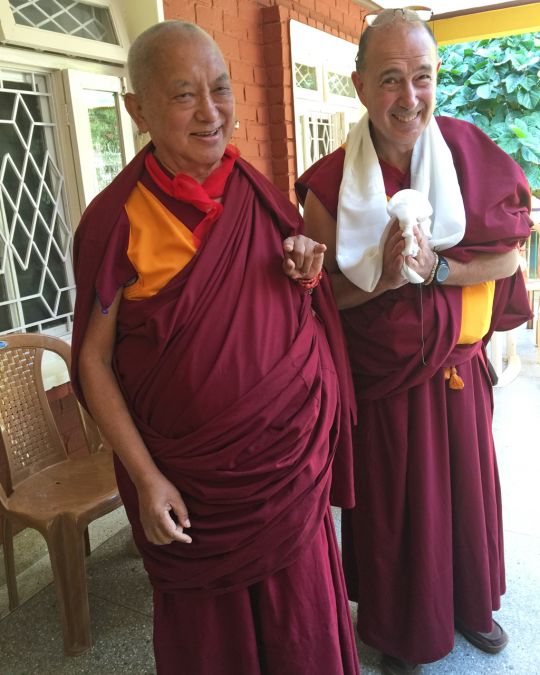
Lama Zopa Rinpoche with Ven. Thubten Kunsang, Sera Monastery, India, January 2016. Photo by Ven. Roger Kunsang.
Jean Yves took care of Ven. Kunsang in the last few months of his life and sent a photo of Ven. Kunsang, his brother Emile and Jean Yves to Lama Zopa Rinpoche, who asked his attendant Ven. Sherab to Photoshop Rinpoche into the picture. Ven. Sherab did and sent the photo back to Ven. Kunsang, his brother and Jean Yves with the message: “Rinpoche looking after Kunsang , JY and brother Emile from behind and above!”

Lama Zopa Rinpoche added to a photo of Emile, Ven. Kunsang and Jean Yves, India
Many pujas were arranged for Ven. Kunsang. In addition, Nalanda Monastery is making 400 long-life tsa-tsas and Peter Iseli will make a White Tara thangka.
Links to text recommended by Rinpoche, Medicine Buddha Sadhana:
https://fpmt.org/wp-content/uploads/education/prayers/medicine_buddha_sadhana_c5.pdf
“Sampa Lhundrupma”:
http://www.tibetanbuddhistaltar.org/wp-content/uploads/2013/12/SAMPA-LHUNDRUP-5x8k.pdf
There will be an obituary for Ven. Kunsang in the next issue of Mandala magazine.
For more on practices recommended by Lama Zopa Rinpoche at time of death and other resources to support yourself and loved ones at time of death, please visit fpmt.org/death/.
- Tagged: obituaries, ven. thubten kunsang
- 0
18
Khensur Rinpoche Lobsang Palden Passes Away
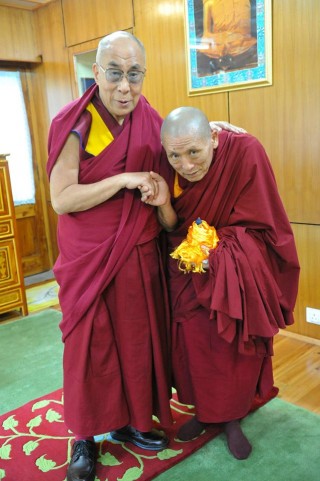
His Holiness the Dalai Lama with Khensur Rinpoche Lobsang Palden
By Ven. Jampa Khedrub
Sera Je Khensur Rinpoche Acharya Geshe Lobsang Palden manifested passing beyond his coarse body on the evening of May 1, 2016, in Taipei, Taiwan, and subsequently remained in the clear light meditation (thuk-dam) until May 6.
His holy body was finally cremated on the morning of May 12 amidst fervent prayers entreated by many of his students from Sera Je who had traveled abroad for the event as well as local devotees. It was the culmination of a life spent in earnest service of the Dharma and others.
Khensur Rinpoche was born within the Kardze district of Tehor Kham in eastern Tibet in around December 1935. At age 11 he entered nearby Dhargyey Monastery, and later at 17 he moved to Sera Je Monastery in Lhasa. Fleeing to India in 1959, he finally achieved the rank of Lharampa Geshe in 1980.
His fame as a scholar and practitioner quickly attracted many hundreds of students, and besides the many formal teachings and initiations he bestowed along the way, he taught Buddhist philosophy to students of the debate program more or less daily for more than 20 years. He was later approved by His Holiness the Dalai Lama as the 73rd Abbot of Sera Je Monastery, a position which he held for seven years (2005-2012).
Mandala will have a complete obituary for Khensur Rinpoche Lobsang Palden in the January-June 2017 issue.
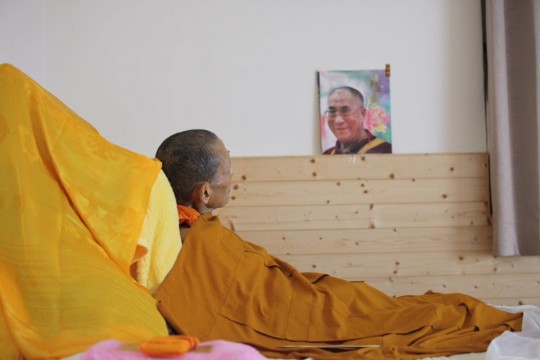
Khensur Rinpoche Lobsang Palden’s body while in clear light meditation, May 2016. Photo courtesy of Ven. Jampa Khedrub.
FPMT.org brings you news of Lama Zopa Rinpoche and of activities, teachings and events from nearly 160 FPMT centers, projects and services around the globe. If you like what you read, consider becoming a Friend of FPMT, which supports our work.
- Tagged: khensur rinpoche lobsang palden, obituaries
- 0
22
Dhakpa Tulku Rinpoche Passes Away
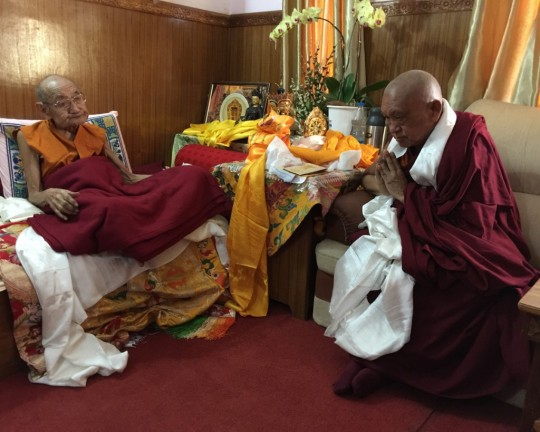
Dhakpa Tulku Rinpoche being visited by Lama Zopa Rinpoche, India, December 2015. Photo by Ven. Roger Kunsang.
We are sad to announce that on February 13, 2016, Dhakpa Tulku Rinpoche passed away peacefully while in meditation at his residence in Kalimpong, India. Dhakpa Rinpoche was one of Lama Zopa Rinpoche’s gurus, was an FPMT touring lama, and had given Lama Zopa Rinpoche many oral transmissions over the years. He will be greatly missed.
Dhakpa Rinpoche was born in 1926 in Kongpo, Tibet and later recognized by His Holiness the 13th Dalai Lama as the reincarnation of the 49th Ganden Tripa Lobsang Dhargye Rinpoche, who was the head of the Gelug school from 1708 to 1715. He studied in Tibet eventually earning his Geshe Lharampa degree at the age of 26 and completing further studies in tantra. When the Chinese communists invaded Tibet in 1959, Rinpoche fled to India.
In 1962, His Holiness the 14th Dalai Lama appointed Rinpoche as the abbot of Sera Me Monastery, the first abbot of the Sera Me in exile. Rinpoche served as abbot for three years, but left the monastery and went to Kalimpong for medical treatment.
Until 1990, Rinpoche led a very quiet life in Kalimpong and spent much of his time in retreat and meditation. Although Rinpoche was one of the most precious and valuable spiritual teachers living in India, due to his humble nature, he was little known outside the area. However, he was in fact one of the very rare teachers holding teachings from the most valuable and precious secret lineages from Pabongka Rinpoche and many other highly realized lamas in Tibet.
Throughout his life Rinpoche actively sought out teachings from spiritual masters from other Tibetan Buddhist traditions, adding to the richness of his understanding and own teachings. Rinpoche was requested to pass on all those teachings and other tantric initiations to the young rinpoches at Sera Me, which he did for three months every winter. His Holiness the Dalai Lama praised Dhakpa Rinpoche for his dedication to his practices and the generosity of his teachings.
Mandala will have a complete obituary for Dhakpa Tulku Rinpoche in the July-December 2016 issue.
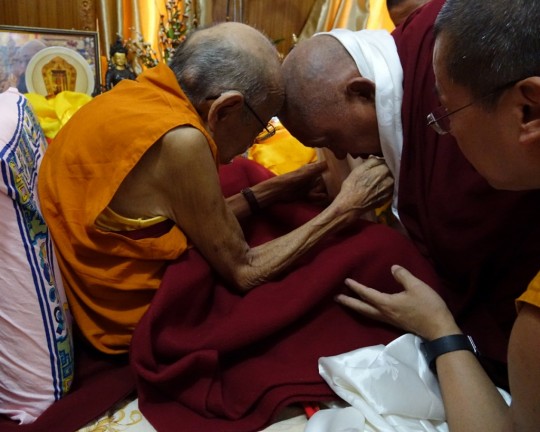
Dhakpa Rinpoche and Lama Zopa Rinpoche, India, December 2015. Photo by Ven. Roger Kunsang.
- Tagged: dhakpa rinpoche, obituaries
- 0
- Home
- News/Media
- Study & Practice
- About FPMT Education Services
- Latest News
- Programs
- New to Buddhism?
- Buddhist Mind Science: Activating Your Potential
- Heart Advice for Death and Dying
- Discovering Buddhism
- Living in the Path
- Exploring Buddhism
- FPMT Basic Program
- FPMT Masters Program
- FPMT In-Depth Meditation Training
- Maitripa College
- Lotsawa Rinchen Zangpo Translator Program
- Universal Education for Compassion & Wisdom
- Online Learning Center
- Prayers & Practice Materials
- Overview of Prayers & Practices
- Full Catalogue of Prayers & Practice Materials
- Explore Popular Topics
- Benefiting Animals
- Chenrezig Resources
- Death & Dying Resources
- Lama Chopa (Guru Puja)
- Lama Zopa Rinpoche: Compendium of Precious Instructions
- Lama Zopa Rinpoche: Life Practice Advice
- Lama Zopa Rinpoche Practice Series
- Lamrim Resources
- Mantras
- Prayer Book Updates
- Purification Practices
- Sutras
- Thought Transformation (Lojong)
- Audio Materials
- Dharma Dates – Tibetan Calendar
- Translation Services
- Publishing Services
- Teachings and Advice
- Find Teachings and Advice
- Lama Zopa Rinpoche Advice Page
- Lama Zopa Rinpoche: Compendium of Precious Instructions
- Lama Zopa Rinpoche Video Teachings
- ༧སྐྱབས་རྗེ་བཟོད་པ་རིན་པོ་ཆེ་མཆོག་ནས་སྩལ་བའི་བཀའ་སློབ་བརྙན་འཕྲིན།
- Podcasts
- Lama Yeshe Wisdom Archive
- Buddhism FAQ
- Dharma for Young People
- Resources on Holy Objects
- Ways to Offer Support
- Centers
- Affiliates Area
- Teachers
- Projects
- Charitable Projects
- Make a Donation
- Applying for Grants
- News about Projects
- Other Projects within FPMT
- Support International Office
- Projects Photo Galleries
- Give Where Most Needed
- FPMT
- Shop
Translate*
*powered by Google TranslateTranslation of pages on fpmt.org is performed by Google Translate, a third party service which FPMT has no control over. The service provides automated computer translations that are only an approximation of the websites' original content. The translations should not be considered exact and only used as a rough guide.Each one of us is responsible for all other living beings’ happiness besides our own. As a result, your loving kindness is the most wish fulfilling thing in life, more precious than anything else in the world. That makes for a most satisfying, fulfilling life.







